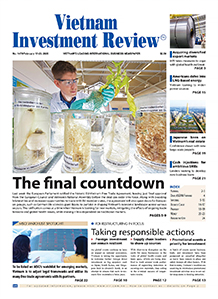Digital sellers embrace affiliate marketing
According to the Affiliate Marketing Global Market report by Business Research Insight, released at the end of April, the global market was valued at $15.1 billion in 2024 and is projected to reach $17.42 billion by the end of 2025. By 2033, the market is expected to surpass $62 billion, registering a compound annual growth rate of 15.2 per cent.
 |
| Digital sellers embrace affiliate marketing, Photo: Le Toan |
“This momentum is driven by the accelerating expansion of e-commerce, increasing consumer reliance on peer-led content, and the growing influence of social platforms as fertile ground for targeted advertising,” said the report. “Additionally, advances in AI and machine learning are enabling more effective campaign targeting and performance optimisation.”
Crucially, Asia is becoming a key driver of this growth. The report highlights that countries such as China, India, and those in Southeast Asia are seeing rapid internet adoption and rising mobile commerce, setting the stage for a dynamic affiliate marketing ecosystem.
Vietnam, in particular, is riding this wave of transformation. As outlined in the Affiliate Marketing Report 2025 by AccessTrade, released in January, e-commerce has become the central pillar of affiliate marketing strategies in both Vietnam and the broader Asia-Pacific region.
The report estimates that Vietnam’s affiliate marketing reached between $700 million and $1 billion in 2024, representing a potential 30-fold increase compared to 2022. Revenues from affiliate activities now account for around 10 per cent of total brand sales, up significantly from 6 per cent just two years prior.
This explosive growth is underpinned by three dominant trends reshaping the affiliate landscape. First is the integration of livestreaming with trusted intermediaries between brands and consumers. Second is the rise of short-form video content across platforms such as TikTok, Facebook, and Instagram. Third is a marked shift in consumer purchasing behaviour, with growing demand for high-value items, including electronics, cosmetics, wellness products, furniture, and automobiles, being fulfilled through online channels.
In tandem with these shifts, Vietnamese enterprises have become increasingly proactive in adopting affiliate marketing. Between 2022 and 2024, AccessTrade recorded a sharp rise in participation, with over 200 business partners across industries such as e-commerce, banking, automotive, and retail. This trend reflects a broader transition, with businesses increasingly incorporating affiliate marketing as a formal component of their digital sales strategies.
Hoang Van Khanh, a representative of a jewellery and watch brand, shared her journey into affiliate marketing through TikTok. Initially creating casual styling videos, she observed growing interest from viewers in purchasing featured items.
“I started by making videos showing how to match jewellery with outfits, and many viewers asked where they could buy the items,” Khanh told VIR. She subsequently joined TikTok’s affiliate programme, integrating purchase links into her content and generating regular income.
Her case reflects the expanding role of affiliate marketing among younger, digitally savvy consumers. According to Khanh, users tend to engage more with relatable, experience-based content than with traditional advertising formats. She now earns between $800 and $1,000 per month from affiliate activities, with around three-quarters of that income generated via TikTok.
She also noted the importance of maintaining audience trust and navigating platform dynamics. “If the products aren’t good or you oversell, your credibility can vanish overnight,” she said. “Recommendation system changes on TikTok can also significantly affect reach, so I need to stay updated on trends and continuously optimise my content.”
The growing importance of technology and data in affiliate marketing is also being acknowledged by platform operators. Nguyen Ngo, marketing manager of TikTok Shop Vietnam, said sellers must increasingly focus on operational excellence.
“As Vietnam’s digital commerce ecosystem becomes more sophisticated, sellers are focusing on both pricing and operational efficiency and service quality to enhance long-term competitiveness,” Ngo told VIR.
To support this shift, TikTok Shop has introduced the ACE index, a strategic framework centred on three pillars: assortment, content, and empowerment. The framework helps sellers refine their operations, deepen customer engagement, and build sustainable growth trajectories in an evolving digital landscape.
One seller exemplifying this shift is Kieu Van Dung, who transitioned from traditional agricultural retail to a digital-first approach via TikTok Shop. Within a year, he has become one of the platform’s top sellers in the agricultural tools segment. E-commerce now comprises 78 per cent of his total revenue, with TikTok Shop alone contributing 72 per cent of that.
Central to Dung’s success is his application of the ACE index, particularly the content pillar. “Rather than producing conventional advertisements, I focus on creating educational videos that offer practical farming tips,” he said. “This content not only provides real value to viewers but also helps establish trust and long-term engagement.”
 | AI leading to significant hikes in e-commerce revenue E-commerce businesses and online retailers are seeking methods to increase revenues with the rising use of AI. |
What the stars mean:
★ Poor ★ ★ Promising ★★★ Good ★★★★ Very good ★★★★★ Exceptional
Related Contents
Latest News
More News
- Businesses ramp up production as year-end orders surge (December 30, 2025 | 10:05)
- Vietjet chairwoman awarded Labour Hero title (December 29, 2025 | 13:06)
- How to unlock ESG value through green innovation (December 29, 2025 | 10:03)
- AI reshapes media and advertising industry (December 29, 2025 | 08:33)
- FPT and GELEX sign deal to develop blockchain tech for global markets (December 29, 2025 | 08:29)
- Vietnam’s GDP forecast to grow by 9 per cent in 2026 (December 29, 2025 | 08:29)
- Women entrepreneurs are key to Vietnam’s economic growth (December 29, 2025 | 08:00)
- Vietnam's top 500 value-creating enterprises announced (December 27, 2025 | 08:00)
- The PAN Group shaping a better future with ESG strategy (December 26, 2025 | 09:00)
- Masan Consumer officially lists on HSX, marking the next phase of value creation (December 25, 2025 | 13:20)

 Tag:
Tag:


















 Mobile Version
Mobile Version